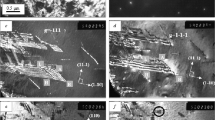Abstract
The behaviour of domain wall-dislocation interaction in Ni-5wt% Mn alloy has been investigated in pre-annealed, quenched and γ-irradiated samples using some magnetic structure-sensitive properties. In all three samples it was found that the initial magnetic susceptibility, χa, and the maximum magnetic susceptibility, χmax, were increased with the degree of plastic strain, and attributed to the formation of loops of domain wall around dislocations during the early stage of deformation. Further increase in dislocation density in the matrix during the later stage of deformation, affects the average value of the strength of interaction between the domain wall and dislocation, thus contributes to the decrease in χa and χmax. The observed changes in the magnetic anisotropy,K, with plastic strain deformation is explained in terms of the magnetic hardening of the material by dislocations. Excess quenched vacancies and their clusters had an observable effect on domain wall-dislocation interaction, which is assumed to be due to the expected interaction and their pinning action that appear in the field of the nickel matrix.
Similar content being viewed by others
References
D. C. Jiles,Phys. Status Solidi (a) 108 (1988) 417.
J. Degauque, B. Aste, J. L. Porteseil andR. Vergne,J. Magn. Magn. Mater. 26 (1982) 261.
H. Trauble, in “Modern Problem der Metall Physik”, edited by A. Seeger (Springer-Verlag, Berlin, 1966) p. 24.
H. D. Dietze,Phys. Kondens. Mater. 2 (1964) 117.
H. Kronmüller,Z. Angew. Phys. 30 (1970) 9.
A. R. Ali, Z. M. Mansy, F. Mohsen andR. Kamel,Physica 112B (1982) 245.
H. R. Hilzinger andH. Kronmüller,ibid. 86–88B (1977) 1365.
S. Chikazumi, “Physics of Magnetism” (Wiley, London, 1964) pp. 277, 263.
E. Czerlinsky,Ann. Physik 13 (1932) 80.
A. R. Ali andG. Said,Physica 112B (1982) 241.
G. Remont, P. Delavignette, A. Lagasse andS. Amelinckx,Phys. Status Solidi 11 (1965) 329.
A. R. Ali, S. A. Mahmoud andG. Said,Phys. Status Solidi (a) 84 (1984) K67.
J. E. Epperson, K. W. Gerstenberg, D. Berner, G. Kostorz andC. Ortiz,Phil. Mag. A 38 (1978) 529.
A. R. Ali andM. A. Fahim,J. Mater. Sci. 25 (1990) 1468.
Author information
Authors and Affiliations
Rights and permissions
About this article
Cite this article
Ali, A.R., Farid, Z.M. & Takla, E. The effect of lattice disorders on domain wall-dislocation interaction in Ni-5wt% Mn alloy. J Mater Sci 27, 5801–5804 (1992). https://doi.org/10.1007/BF01119741
Received:
Accepted:
Issue Date:
DOI: https://doi.org/10.1007/BF01119741




